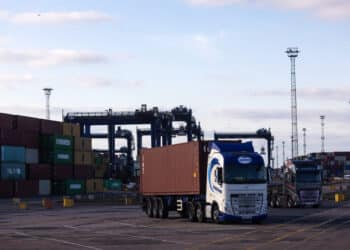Ford Motor Co. is developing its strategy for how to best manage the tariff situation, John Lawler, vice chair and chief financial officer, said during the Bank of America Securities Automotive Summit on April 16.
“We have the most hourly workers, and we export the most vehicles from the U.S., so I think that gives us a unique position,” he said. “We’re all working through that right now to understand how all the tariffs align, what the impact is going to be, how we’re going to work through this, and so we’re going to work on managing what we can control, continue to engage the dialog and continue to work through this.”
The automotive and commercial vehicle industry must change its thinking as it undergoes a drastic transformation driven by rapid innovation, the rise of Chinese competitors and accelerating electrification, which all demand significant capital and collaboration, Lawler said.
“We have to think about joint ventures, we have to think about partnerships, and maybe there will be consolidation, but if something doesn’t change, all of us can’t do all of this on our own, especially with what has been our largest profit pools and cash generators in this industry over the last 10 to 12 years drying up,” he said.
“I think that this is going to be an inflection point for the industry and every company in the industry regardless of what happens with tariffs,” John Lawler said.
As innovation, competition and electrification shift the automotive and commercial vehicle industry, especially in the face of tariffs, manufacturers, dealers and lenders must navigate purchasing and financing for fleets and vehicles.
Ford growing connected vehicles
Meanwhile, Ford is developing its connected vehicle and integrated services with Ford Pro, its commercial vehicle division, Lawler said.
“We’re well along the path with the connected vehicle and what we’re doing, starting with Pro and the integrated services that we’re building out, and it’s not just software, it is the physical services,” he said. “We capture about 37% of the physical services that are available to us, and every point of share is worth $30 million of EBIT.”
Ford’s connected vehicle technology is opening new opportunities to capture a larger share of the vehicle lifetime revenue currently untapped by dealerships, Lawler said. While dealers already account for $1.2 trillion in revenue and $53 billion in profit, an additional $1.2 trillion and $133 billion in profit remain outside the traditional dealership ecosystem.
Developing Ford Pro
As Ford aims to maximize its penetration in physical services, it is also looking to data to improve its uptime and penetration with commercial customers, Lawler said.
“All of those things are going to allow us to have a different relationship with the customer to create value and that’s going to allow us to grow, we think — especially in Pro — our penetration, our share of wallet and then the ability to drive significant benefit for our commercial customers.”
Part of the relationship development between Ford and commercial vehicle customers depends on the ability to coordinate with Ford Pro dealers, Lawler said.
“We can’t do that on our own, we have to do that with the dealers,” he said. “We have some very, very good commercial dealers out there that understand the commercial business.”
Shares of Ford Motor Co. [NYSE: F] were up 2.45% or 23 cents from market open to $9.63 as of market close today. The company has a market cap of $37.4 billion.
The third annual Equipment Finance Connect at the JW Marriott Nashville in Nashville, Tenn., on May 14-15, 2025, is the only event that brings together equipment dealers and lenders to share insights, attend discussions on crucial industry topics and network with peers. Learn more about the event and register here.









